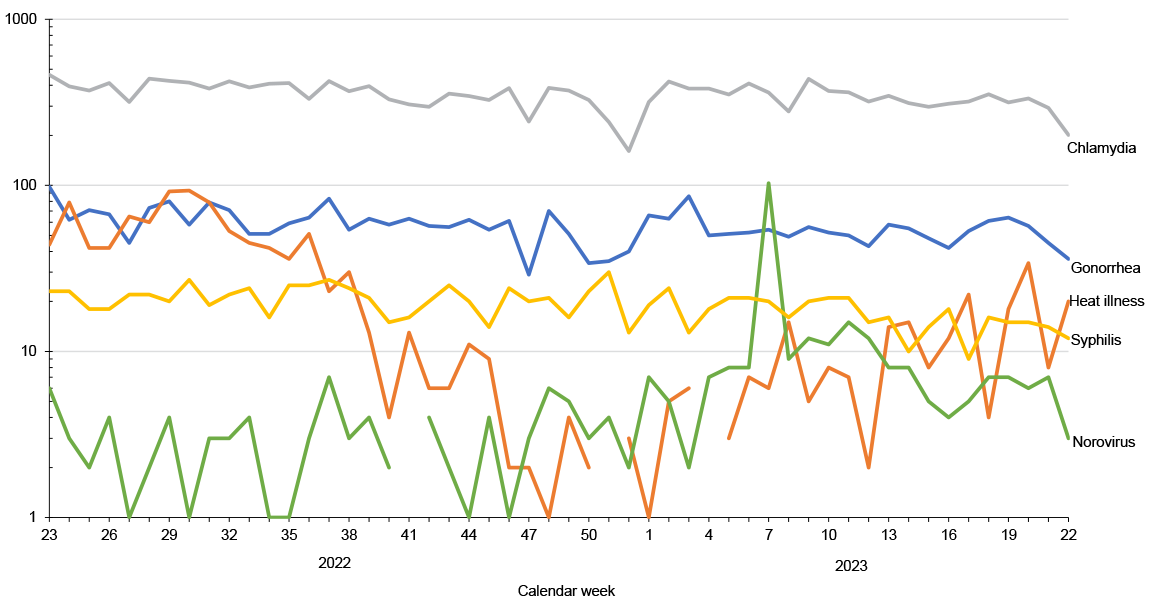Reportable Medical Events, Military Health System Facilities, Week 22, Ending June 3, 2023
 Graph depicting the frequency of the five most common reportable medical events within the Military Health System over the preceding year.
Graph depicting the frequency of the five most common reportable medical events within the Military Health System over the preceding year.
Reportable Medical Events are documented in the Disease Reporting System internet by health care providers and public health officials across the Military Health System for the purpose of monitoring, controlling, and preventing the occurrence and spread of diseases of public health interest or readiness importance. These reports are reviewed by each service’s public health surveillance hub. The DRSi collects reports on over 70 different RMEs, including infectious and non-infectious conditions, outbreak reports, STI risk surveys, and tuberculosis contact investigation reports. A complete list of RMEs is available in the 2022 Armed Forces Reportable Medical Events Guidelines and Case Definitions.1 Data reported in these tables are considered provisional and do not represent conclusive evidence until case reports are fully validated.

Total active component cases reported per week are displayed for the top five RMEs for the previous year. Each month, the graph is updated with the top five RMEs, and is presented with the current month’s (May 2023) top five RMEs, which may differ from previous months. COVID-19 is excluded from these graphs due to changes in reporting/case definition updates in 2023.

References
- Armed Forces Health Surveillance Division. Armed Forces Reportable Medical Events. Accessed April 6, 2023. https://www.health.mil/Military-Health-Topics/Health-Readiness/AFHSD/Reports-and-Publications/Armed-Forces-Reportable-Medical-Events
- Defense Manpower Data Center. Department of Defense Active Duty Military Personnel by Rank/Grade of Service, October 31, 2022. https://dwp.dmdc.osd.mil/dwp/app/dod-data-reports/workforce-reports
- Defense Manpower Data Center. Armed Forces Strength Figures for January 31, 2023. https://dwp.dmdc.osd.mil/dwp/app/dod-data-reports/workforce-reports
- Navy Medicine. Surveillance and Reporting Tools–DRSI: Disease Reporting System Internet. https://www.med.navy.mil/Navy-Marine-Corps-Public-Health-Center/Preventive-Medicine/Program-and-Policy-Support/Disease-Surveillance/DRSI
You also may be interested in...
Article
May 20, 2022
The Air Force Medical Service tasked the 39th Medical Group to test the service’s first blended curriculum, enhancing the readiness and skills of medical personnel, Soldiers, and NATO allies at Incirlik Air Base, Turkey, April 20-24, 2022.
Fact Sheet
May 12, 2022
 .PDF |
160.12 KB
.PDF |
160.12 KB
This document shows the flow chart for how the PDBR processes requests for reviews of disability ratings.
Photo
May 12, 2022
U.S. Marines and U.S. Navy Corpsmen with 1st Marine Division asses the injuries under the supervision of evaluators during an Expeditionary Medical Integration Course (EMIC) on Camp Pendleton, California May 5, 2022.
Photo
May 12, 2022
U.S. Army Sgt. 1st Class Mathew Maxwell (Left) and U.S. Capt. Brian Ahern, medical personnel assigned to a Defense POW/MIA Accounting Agency recovery team, check the pulse of a local villager during excavation operations in the Houaphan province, Laos, Feb. 5, 2019. (Photo by Staff Sgt. Michael O'Neal)
Article
May 12, 2022
I Marine Expeditionary Force's Expeditionary Operations Training Group on Camp Pendleton developed the Expeditionary Medical Integration Course to prepare Marines and line corpsmen for future deployments.
Article
May 12, 2022
Treating wounded soldiers for the first time was a life-changing experience for this enlisted medic.
Article
May 9, 2022
Military Sealift Command hospital ship USNS Mercy (T-AH 19) departed San Diego, May 3, marking the beginning of Pacific Partnership 2022 (PP22).
Report
May 1, 2022
 .PDF |
1.25 MB
.PDF |
1.25 MB
A monthly publication of the Armed Forces Health Surveillance Division. This issue of the peer-reviewed journal contains the following articles: Update: Sexually transmitted infections, active component, U.S. Armed Forces, 2013–2021; Evaluation of ICD-10-CM-based case definitions of ambulatory encounters for COVID-19 among Department of Defense health ...
Article
May 1, 2022
This report summarizes incidence rates of the 5 most common sexually transmitted infections (STIs) among active component service members of the U.S. Armed Forces during 2013–2021. In general, compared to their respective counterparts, younger service members, non-Hispanic Black service members, those who were single and other/unknown marital status, ...
Article
May 1, 2022
This is the first evaluation of ICD-10-CM-based cased definitions for COVID-19 surveillance among DOD health care beneficiaries. The 3 case definitions ranged from highly specific to a lower specificity, but improved balance between sensitivity and specificity.
Article
May 1, 2022
Tick-borne Encephalitis in Military Health System Beneficiaries, 2012–2021. Tick-borne encephalitis (TBE) is a viral infection of the central nervous system that is transmitted by the bite of infected ticks, mostly found in wooded habitats in parts of Europe and Asia
Article
May 1, 2022
Data from surveys may be used to make public health decisions at both the installation and the Department of the Army level. This study demonstrates that a vast majority of soldiers were likely sufficiently engaged and answered both bogus items correctly. Future surveys should continue to investigate careless responding to ensure data quality in ...
Article
Apr 19, 2022
The Combat Lifesaver Course is a three-day course that teaches Marines lifesaving medical techniques to eliminate preventable loss of life on the battlefield.
Article
Apr 15, 2022
Nigerien and U.S. doctors alongside U.S. joint service medical specialists established a temporary field clinic to provide medical treatment to citizens of Ouallam and the surrounding areas as a part of a medical civic action program (MEDCAP) in Ouallam, Niger, March 16, 2022.
Article
Apr 11, 2022
During his speech at HIMSS, Lt. Gen. Place discusses clear and present dangers to military medical care.
You are leaving Health.mil
The appearance of hyperlinks does not constitute endorsement by the Department of Defense of non-U.S. Government sites or the information, products, or services contained therein. Although the Defense Health Agency may or may not use these sites as additional distribution channels for Department of Defense information, it does not exercise editorial control over all of the information that you may find at these locations. Such links are provided consistent with the stated purpose of this website.
You are leaving Health.mil
View the external links disclaimer.
Last Updated: August 24, 2023